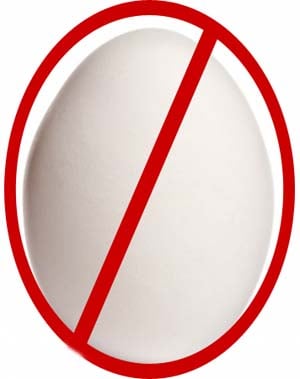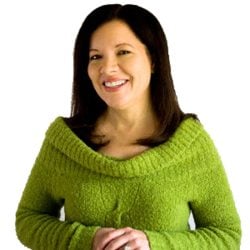For those who are also completely egg-free, you may find this list of egg substitutes very helpful. There are 3 basic purposes of using egg in a recipe: to moisten, to bind ingredients together, or to leaven (rise). Depending on the purpose, will depend upon the egg substitute used. Using an egg substitute is a great way to lower your cholesterol and calorie intake, as well. I especially like the use of flax seed meal as an egg replacer. Though agar-agar works very well, too, it is quite expensive. I am constantly discovering new gluten free egg substitutes. So check back often. I usually add a dated update for new discoveries.
Also visit the Gluten Free Egg Free Recipes category where you’ll find over 700 recipes.

UPDATE FEB 5, 2022 – My latest favorite Gluten Free Egg White Substitute…
Use 2 tablespoons bean liquid (aquafaba).
Egg Yolk Substitute…
To replace one egg yolk…
Use 1 tablespoon butter, other fat, such as bacon.
Or better yet…
Use 1 teaspoon soy or sunflower lecithin plus 2 teaspoons fat. Egg yolks contain lecithin and help create a more manageable dough in bread and pastry molding.
UPDATE OCTOBER 1, 2015 – See the latest new, amazing egg and egg white substitute. You can even make meringue!
UPDATE October 3, 2013: Many of you asked whether my bread recipe can be made egg free. I finally got around to experimenting and have now successfully made an egg-free gluten-free bread recipe. Check out the egg substitute and the link to the bread recipe at Gluten Free Egg Substitute for Gluten Free Bread Recipes.
Egg Substitute Choices
- Tapioca Gel makes a wonderful egg replacer for leavening, and is the least expensive: 1 cup water, plus 2 1/2 teaspoons tapioca flour/starch – whisk well in a small sauce pan; on medium high heat, bring to a boil; whisk for about 30 seconds (it will be translucent); set aside to cool completely until it turns into a gel consistency. If it is too thick, water it down with room temperature water. Use in equal amount to substitute whole eggs. There is 3¼ tablespoons in one large egg. Discard unused portion as it will lose its consistency and effectiveness in a few hours. This works well in recipes not needing leavening qualities, though it does provide some leavening.
- Flax Seed Gel makes a great egg substitute: 1 Tablespoon finely ground flax seed meal + 3 tablespoons water whipped until it is the consistency of egg; equals one egg. This works well if the egg in the recipe is for the purpose of binding the other ingredients together. If a recipe calls for egg to leaven (rise), add 1/2 teaspoon baking powder. For moisture, I also like to add 2 Tablespoons unsweetened applesauce. It make the perfect egg yolk replacer.
- Baking Powder, Oil and Water: Mix together well, 2 tablespoons water, 1 tablespoon cooking oil, and 2 teaspoons baking powder.
- Unflavored Gelatin mixed with water also works, but it is not a natural ingredient.
- Avocado makes another great egg substitute. I use it in homemade ice cream and chocolate ganache! No need to cook it either! 1 avocado = about 2 eggs or less. (high in fat, but is good fat) It is best used as a substitute when the egg called for in the recipe is used for added fat.
- Egg Replacer mixed with milk, or a milk substitute (one with protein is best: almond milk, soy milk, etc.) Ener-G makes a gluten free Egg Replacer.
- Agar agar used for egg white substitute: 1 tablespoon of agar agar powder +1 tablespoon of water; whip, chill and whip again – equals 1 egg.
- Fresh fruit, such as pureed bananas, pears or applesauce make an excellent substitute, if the only purpose of the egg is moisture. 1/2 large banana or 1/4 cup apple/pear sauce works great for each egg along with 1 teaspoon baking powder. These are best used in cakes and muffin recipes. They add more moisture than egg, therefore, you may need to add to the baking time. They add a little sweetness, as well, therefore, you may wish to consider lessening any sugar called for in the recipe. Banana adds more sweetness than pears or applesauce. I usually add about 1/2 teaspoon of baking soda or 1 teaspoon baking powder (whatever the recipe calls for, or as an addition).
- Xanthan gum may be used to replace one egg in a recipe. Whip together 1/4 teaspoon of xanthan gum in 1/4 cup water. It has no leavening properties.
- Meatloaf, Stuffing, and Hamburger Egg Substitute: Whip together 1 cup water and 1/2 cup gluten free flour in a blender until it thickens. Add to a bowl and cook over a simmering sauce pan with a bit of water for 45-60 minutes. Whip until fluffy. Add 1 tablespoon oil and a pinch of salt. Use 3 tablespoons as an egg substitute. (UPDATE: You can also use starch, arrowroot is my favorite to create a light fluffy adhesive to meatloaf and the like. To substitute one whole egg, mix 1 tablespoon arrowroot with 2 tablespoons of water. One large egg contains about 3 tablespoons of liquid.)
- Extra Baking Powder: If using any of the above in baking and the original purpose of the egg was as a leavening agent (for rising), add extra baking powder to the recipe.
- Baking Soda: If you choose to use baking soda instead of baking powder, realize that baking soda can make your baked goods bitter. Never use more than 1 teaspoon of baking soda in a 2 cup flour recipe. One teaspoon of baking powder is equal to about 1/4 teaspoon baking soda.
- Vinegar: In addition, adding a teaspoon or two of apple cider vinegar will also lighten up your baked recipes and cause bubbles to form when mixed with baking soda, which results in little holes, a lighter and airy end product. Whipping your liquids will also help lighten the end product.
Most of the above are also vegan, except for the gelatin as it is an animal byproduct.
Notes:
These substitutes do not work well in recipes that call for a lot of egg such as souffles and meringues. I do know some vegans who use whipped, soft tofu in soufflés successfully, though.
I have not used all of these egg substitutes. Some are just ones I have run across and found thought you would find them useful.
Enjoy!



I am sensitive to egg whites and have learned to eat only yolks. However, how do you make a substitution for the whites in a recipe. I have used a product called “the Neat Egg” which is made from ground chia and garbanzo beans. I would like to know if I can use the yolks only, rather than substituting the whole egg in a recipe. Thanks.
Patricia,
See the link in the Update from October 2015. There you will find that canned bean liquid (white beans) may be used to substitute egg white. Use 2 tablespoons bean liquid to replace the egg white in a large egg. Then use 1 tablespoon egg yolk along with the 2 tablespoons bean liquid and you should have yourself an egg-white-free egg substitute.
Carla
Hi i sent a previous comment but forgot to tick the box i’m not a robot. I hope this works
this was not help full at all
This pages is EXCEEDINGLY helpful. I help take care of my Mom, who has developed food allergy and sensitivity issues and this is the ONLY page I have come across in many months that is well-written, well-explained and free of typo’s (critical when listing measurements for baking ingredient/substitutes). Thanks, Carla, for your attention to detail and understanding your readers!
I’ve found gf cake recipes that call for as many as 6 eggs or even more. I realize the info above is generally for 1 egg, but will the recipes work if you use egg replacement for such a large amount of eggs? I’d hate to waste the ingredients if I am unable to replace so many eggs since I’m unable to tolerate egg yolks. Thanks!
Cynthia,
It is the consensus of the gluten-free egg-free community that you can only use egg replacer to substitute up to two eggs. Using the tapioca gel may substitute more. The creator is Cake and Commerce: http://www.cakeandcommerce.com/cake_and_commerce/2011/01/in-search-of-a-better-egg-substitute-for-egg-free-and-vegan-baking.html. She suggested to one of her readers to use 1 cup of water plus 1 teaspoon tapioca gel as to replace 6 eggs, and if it didn’t work out well to reduce the gel/water as needed. She finds that you do not need to use xanthan gum when you use this as an egg replacer.
I hope this helps!
Carla
Um… baking soda and baking powder… they are different, right?
Hi tardisblue,
Yes. Baking soda is activated as soon as it is mixed with a liquid and continues to act/rise when exposed to heat, as in the oven. Baking powder mostly reacts to heat.
I hope this helps.
Carla
In the baking powder section you mention both baking powder and baking soda. So do I add powder or soda? Very confusing.
Hi Katie,
Sorry for the confusion. I have updated that section and hope you find it clearer now.
Thanks,
Carla
How does one know what the egg’s purpose in a recipe is? I am guessing that anything with yeast, the egg is meant as a leavener. Is that the only time an egg is used for such a purpose or is it all baked goods? Thank you!
Eva, there are several reasons why eggs are used in baking. Without getting technical: egg yolks add color and help fats stay separated, moisture, leavener, to soften texture/crumb, egg whites provide volume and hold ingredients together (binder), as a thickener, and for added protein.
I hope this clarifies things for you.
Carla
Hello, I have agar agar strips with me and not powder. I searched for it, but couldn’t find it. Is it alright if I grind it in a mixer and make it like a powder and then use it for substitution?